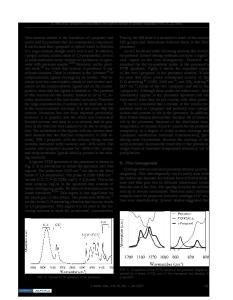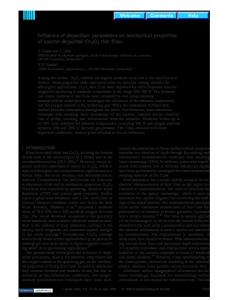Comparative studies on BaZr x Ti 1-x O 3 thin films deposited by Sol-gel and Pulse laser deposition
- PDF / 290,581 Bytes
- 6 Pages / 612 x 792 pts (letter) Page_size
- 74 Downloads / 354 Views
C8.18.1
Comparative studies on BaZrxTi1-xO3 thin films deposited by Sol-gel and Pulse laser deposition A.Dixit, P.Bhattacharaya, S.B. Majumder, and R.S.Katiyar Department of Physics, University of Puerto Rico, San Juan, PR-00931-3343 A.S. Bhalla Materials Research Center, Pennsylvania State University, University Park, PA 16802 ABSTRACT Ferroelectric thin films of BaZrxTi1-xO3 (BZT) were deposited on platinum (Pt) and platinized silicon (Pt/Si) substrates by sol-gel and pulse laser deposition technique respectively. The structure and preferred orientation of the films were examined by x-ray diffraction measurements. The phase formation of sol-gel derived BZT films were found to be at high temperature (11000C) compare to the pulse laser deposited BZT films ~ 7000C. Polycrystalline films were observed by both techniques. Ferroelectric nature of the films was confirmed by hysteresis and capacitance-voltage characteristics using platinum top electrodes. Dielectric constant as well as loss was found to decrease by increasing Zr contents. Surface morphology predicted smooth crack free surface. INTRODUCTION Ferroelectric thin films find usage in many electronic and electro-optic devices. Some important ferroelectric thin film materials are BaSrTiO3, PbTiO3, Pb (ZrxTi1-x)O3, SrBiTaO3, Pb(Mg1/3Nb2/3)O3 and Bi4Ti3O12. The applications of ferroelectric thin films are based upon their unique dielectric, piezoelectric, pyroelectric, and electro-optic properties [1,2,3]. These properties significantly depend upon the growth technique. There exist several methods for preparing thin films by physical and chemical methods. The physical methods can be divided into thermal evaporation and sputtering and the chemical ones into vapor phase and liquid phase. Among physical vapor deposition techniques the pulse laser deposition technique is known to deposit ferroelectric thin films of high quality at the laboratory scale [4]. By this technique the materials are laser ablated and deposited onto substrates to form stoichiometric thin films. The sol-gel processing of thin films on the other hand has many advantages, which include superior stoichiometry control and ease of compositional modification, easier deposition of the large area films by using simple and inexpensive equipment [5]. In the present work, we have used both techniques to prepare non-lead based multiferroic materials, which are relatively environmentally safe compared to lead based materials. Barium Titanate, BaTiO3, is a perovskite-type ferroelectric with tetragonal symmetry at room temperature and possesses relatively large dielectric constant and electrooptic coefficients. It is chemically and mechanically more stable and it exhibits ferroelectric properties upto 1200C. Due to its ferroelectricity and excellent non-linear optical properties barium titanate thin films are promising in memory devices, dielectric thin
C8.18.2
films, electrooptic devices and other applications [6]. Doped barium titanate thin films, such as (Ba1-x Srx) TiO3, Ba (ZrxTi1-x) O3 and Ba (SnxTi1
Data Loading...











